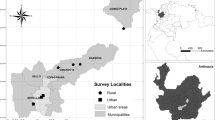Abstract
In noisy conditions, several avian species modulate their songs in amplitude and in the temporal or frequency domains, presumably to improve communication. Most studies on how passerine birds perform such adjustments have been carried out in oscines, a group well known for the importance of learning in the development of their songs. On the other hand, suboscines, in which learning appears to have little influence on the development of their songs, have been largely neglected. We evaluated song adjustment to noise in the vermilion flycatcher (Pyrocephalus rubinus), a suboscine bird. We conducted song recordings and noise measurements at several territories within Mexico City during the length of the dawn chorus. Males living in noisier places sang long songs, while those males inhabiting quieter places sang both short and long songs. We also found evidence of individual song plasticity, as males sang less versatile songs (i.e., songs with more introductory elements) later in the morning when noise levels were higher. This individual shift in song seems to be more associated to time of the day rather than to the observed rise in noise. However, we cannot discard an effect of noise, which should be evaluated with an experiment. We discuss our results in the context of other studies with oscine passerines and other taxa and consider implications for signaling in intra- and intersexual contexts.



Similar content being viewed by others
References
Bermúdez-Cuamatzin E, Ríos-Chelén AA, Gil D, Macías Garcia C (2009) Strategies of song adaptation to urban noise in the house finch: syllable pitch plasticity or differential syllable use? Behaviour 146:1269–1286
Bermúdez-Cuamatzin E, Ríos-Chelén AA, Gil D, Macías Garcia C (2011) Experimental evidence for real-time song frequency shift in response to urban noise in a passerine bird. Biol Lett 7:36–38
Brumm H (2004) The impact of environmental noise on song amplitude in a territorial bird. J Anim Ecol 73:434–440
Brumm H, Slabbekoorn H (2005) Acoustic communication in noise. Adv Stud Behav 35:151–209
Brumm H, Slater PJB (2006) Ambient noise, motor fatigue, and serial redundancy in chaffinch song. Behav Ecol Sociobiol 60:475–481
Brumm H, Voss K, Köllmer I, Todt D (2004) Acoustic communication in noise: regulation of call characteristics in a New World monkey. J Exp Biol 207:443–448
Catchpole CK, Slater PJB (2008) Bird song: biological themes and variations. Cambridge University Press, Cambridge
Chesser RT (2004) Molecular systematics of New World suboscine birds. Mol Phylogenet Evol 32:11–24
Christie PJ, Mennill DJ, Ratcliffe LM (2004) Pitch shifts and song structure indicate male quality in the dawn chorus of black-capped chickadees. Behav Ecol Sociobiol 55:341–348
Eens M, Rivera-Gutierrez HF, Pinxten R (2012) Are low-frequency songs sexually selected, and do they lose their potency in male–female interactions under noisy conditions? P Natl Acad Sci USA 109:E208
Fernández-Juricic E, Poston R, de Collibus K, Morgan T, Bastain B, Artin C, Jones K, Treminio T (2005) Microhabitat selection and singing behavior patterns of male house finches (Carpodacus mexicanus) in urban parks in a heavily urbanized landscape in the western U.S. Urban Habitats 3:49–69
Forstmeier W, Kempenaers B, Meyer A, Leisler B (2002) A novel song parameter correlates with extra-pair paternity and reflects male longevity. Proc R Soc Lond B 269:1479–1485
Francis CD, Ortega CP, Cruz A (2009) Noise pollution changes avian communities and species interactions. Curr Biol 19:1415–1419
Francis CD, Ortega CP, Cruz A (2011a) Vocal frequency change reflects different responses to anthropogenic noise in two suboscine tyrant flycatchers. Proc R Soc Lond B 278:2025–2031
Francis CD, Ortega CP, Cruz A (2011b) Different behavioural responses to anthropogenic noise by two closely related passerine birds. Biol Lett 7:850–852
Fuller RA, Warren PH, Gaston KJ (2007) Daytime noise predicts nocturnal singing in urban robins. Biol Lett 3:368–370
Galeotti P, Saino N, Sacchi R, Møller A (1997) Song correlates with social context, testosterone and body condition in male barn swallows. Anim Behav 53:687–700
Gross K, Pasinelli G, Kunc HP (2010) Behavioral plasticity allows short-term adjustment to a novel environment. Am Nat 176:456–464
Halfwerk W, Slabbekoorn H (2009) A behavioral mechanism explaining noise-dependent frequency use in urban birdsong. Anim Behav 78:1301–1307
Halfwerk W, Holleman LJM, Lessells CM, Slabbekoorn H (2011a) Negative impact of traffic noise on avian reproductive success. J Appl Ecol 48:210–219
Halfwerk W, Botb S, Buikxa J, van der Velde M, Komdeur J, ten Cate C, Slabbekoorn H (2011b) Low-frequency songs lose their potency in noisy urban conditions. P Natl Acad Sci USA 108:14549–14554
Hanna D, Blouin-Demers G, Wilson DR, Mennill DJ (2011) Anthropogenic noise affects song structure in red-winged blackbirds (Agelaius phoeniceus). J Exp Biol 214:3549–3556
Hasselquist D, Bensch S, von Schantz T (1996) Correlation between male song repertoire, extra-pair paternity and offspring survival in the great reed warbler. Nature 381:229–232
Hu Y, Cardoso GC (2009) Are bird species that vocalize at higher frequencies preadapted to inhabit noisy urban areas? Behav Ecol 20:1268–1273
Jouventin P, Aubin T, Lengagne T (1999) Finding a parent in a king penguin colony: the acoustic system of individual recognition. Anim Behav 57:1175–1183
Kuitunen M, Rossi E, Stenroos A (1998) Do highways influence density of land birds? Environ Manage 22:297–302
Lengagne T, Aubin T, Lauga J, Jouventin P (1999) How do king penguins (Aptenodytes patagonicus) apply the mathematical theory of information to communicate in windy conditions? Proc R Soc Lond B 266:1623–1628
Love EK, Bee MA (2010) An experimental test of noise-dependent voice amplitude regulation in Cope’s grey treefrog, Hyla chrysoscelis. Anim Behav 80:509–515
Moran MD (2003) Arguments for rejecting the sequential Bonferroni in ecological studies. Oikos 100:403–405
Murphy MT, Sexton K, Dolan AC, Redmond LJ (2008) Dawn song of the eastern kingbird: an honest signal of male quality? Anim Behav 75:1075–1084
Nakagawa S (2004) A farewell to Bonferroni: the problems of low statistical power and publication bias. Behav Ecol 15:1044–1045
Nemeth W, Brumm H (2009) Blackbirds sing higher-pitched songs in cities: adaptation to habitat acoustics or side-effect of urbanization? Anim Behav 78:637–641
Parris KM, Schneider A (2008) Impacts of traffic noise and traffic volume on birds of roadside habitats. Ecol Soc 14:29
Patricelli GL, Blickley JL (2006) Avian communication in urban noise: causes and consequences of vocal adjustment. Auk 123:639–649
Podos J (1997) A performance constraint on the evolution of trilled vocalizations in a songbird family (Passeriformes: Emberizidae). Evolution 51:537–551
Potash LM (1972) Noise-induced changes in calls of the Japanese quail. Psychon Sci 26:252–254
Potvin DA, Parris KM, Mulder RA (2011) Geographically pervasive effects of urban noise on frequency and syllable rate of songs and calls in silvereyes (Zosterops lateralis). Proc R Soc Lond B 278:2464–2469
Reijnen R, Foppen R (1994) The effects of car traffic on breeding bird populations in woodland. I. Evidence of reduced habitat quality for willow warblers (Phylloscopus trochilus) breeding close to a highway. J Appl Ecol 31:85–94
Reijnen R, Foppen R, ter Braak C, Thissen J (1995) The effects of car traffic on breeding bird populations in woodland. III. Reduction of density in relation to the proximity of main roads. J Appl Ecol 32:187–202
Ríos Chelén AA, Macías Garcia C, Riebel K (2005) Variation in the song of a sub-oscine, the vermilion flycatcher. Behaviour 142:1121–1138
Ríos-Chelén AA (2009) Bird song: the interplay between urban noise and sexual selection. Oecol Brasil 13:153–16
Ríos-Chelén AA, Macías Garcia C (2007) Responses of a sub-oscine bird during playback: effects of different song variants and breeding period. Behav Process 74:319–325
Ríos-Chelén AA, Macias-García C (2004) Flight display song of the vermilion flycatcher. Wilson Bull 116:360–362
Ríos-Chelén AA, Salaberria C, Barbosa I, Macías Garcia C, Gil D (2012) The learning advantage: bird species that learn their song show a tighter adjustment of song to noisy environments than those that do not learn. J Evol Biol. doi:10.1111/j.1420-9101.2012.02597.x
Slabbekoorn H, den Boer-Visser A (2006) Cities change the songs of birds. Curr Biol 16:2326–2331
Slabbekoorn H, Peet M (2003) Birds sing at higher pitch in urban noise. Nature 426:267–267
Smith WJ (1967) Displays of the vermilion flycatcher (Pyrocephalus rubinus). Condor 69:601–605
Swaddle JP, Page LC (2007) High levels of environmental noise erode pair preferences in zebra finches: implications for noise pollution. Anim Behav 74:363–368
Tumer EC, Brainard MS (2007) Performance variability enables adaptive plasticity of ‘crystallized’ adult birdsong. Nature 450:1240–1244
Verzijden MN, Ripmeester EAP, Ohms VR, Snelderwaard P, Slabbekoorn H (2010) Immediate spectral flexibility in singing chiffchaffs during experimental exposure to highway noise. J Exp Biol 213:2575–2581
Wood WE, Yezerinac SM (2006) Song sparrow (Melospiza melodia) song varies with urban noise. Auk 123:650–659
Zollinger SA, Podos J, Nemeth E, Goller F, Brumm H (2012) On the relationship between, and measurement of, amplitude and frequency in bird song. Anim Behav 84:e1–e9
Acknowledgments
Fundación Banco Bilbao Vizcaya Argentaria provided financial support during this work. The authors thank Aaron Goodman for checking the English grammar of the manuscript.
Conflict of interest
The authors declare that they have no conflict of interest.
Ethical standards
This study complies with the current laws of the country where it was performed.
Author information
Authors and Affiliations
Corresponding author
Additional information
Communicated by H. Brumm
Rights and permissions
About this article
Cite this article
Ríos-Chelén, A.A., Quirós-Guerrero, E., Gil, D. et al. Dealing with urban noise: vermilion flycatchers sing longer songs in noisier territories. Behav Ecol Sociobiol 67, 145–152 (2013). https://doi.org/10.1007/s00265-012-1434-0
Received:
Revised:
Accepted:
Published:
Issue Date:
DOI: https://doi.org/10.1007/s00265-012-1434-0




